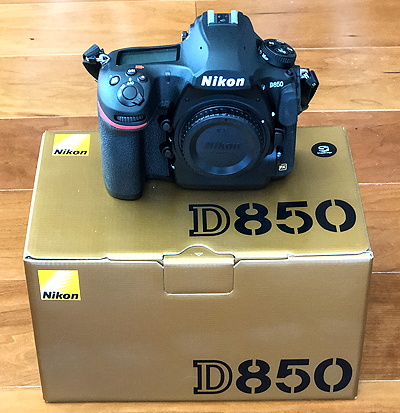Review - Astrophotography with the Nikon D850 DSLR
Posted: 6 February 2018

D850 DSLR
$3297
Nikon
When Nikon began shipping its new D850 DSLR in the fall of 2017 I (and many others) got very excited about this full-frame camera. I had last used a full-frame 35mm film SLR from 1968 to the early 2000s: a Pentax Spotmatic 35mm SLR. I have used the following Nikon DSLRs for general photography and astrophotography: D70, D7000, and D7200.
Through the end of 2017 I did a lot of research into the D850 and on 4 January 2018 I ordered it (and several accessories) from B & H Photo Video. Unlike in the past when I upgraded to a new DSLR and traded in my previous DSLR, I decided that this time I would keep my D7200 DSLR. Having a second DSLR will be handy at times, such as during lunar and solar eclipses. Due to the camera's popularity with professional photographers, the D850 was still on backorder in early January and my camera did not arrive until 2 February.
The basic specifications for the D850 are:
45.7MP FX-Format CMOS Sensor
Sensor size: 35.9 mm x 23.9 mm; 8256 x 5504 pixels
Shutter: 30 seconds - 1/8000 second , Bulb Mode
Native ISO: 64-25600, Extended: 32-102400
3.2" 2.36m-Dot Tilting Touchscreen LCD
Weight (body with battery & XQD card): 2.2 lb
While many of my D7200 DSLR lenses and accessories will work with the D850, I needed a short focal length FX lens for the D850. After much debating I finally decided on the Tamron SP 24-70mm f/2.8 Di VC USD G2 Lens ($1199). This lens is a little shorter, lighter (weight 1.98 lb), and about half the price of the comparable Nikon model.
Here is the D850 DSLR with Tamron lens next to my D7200 DSLR:

D7200 DLSR (APS-C DX format) vs D850 DSLR (full-frame FX format) Comparisons
I was curious about the actual field-of-view differences between the DX and FX cameras with my various lenses. I set up both cameras on tripods. I used Vello Wireless ShutterBoss remotes on both cameras.

Here are the results (full frame) with my various lenses with the D7200 (DX) on the left and the D850 (FX) on the right:
Rokinon 8mm fisheye


Nikon 70-300mm
70mm


Nikon 70-300mm
300mm


Tamron 150-600mm
150mm


Tamron 150-600mm
600mm


The 8mm 180° fisheye lens only has the full 180° diagonally with the D7200. The D850 + 8mm fisheye image surprised me since it doesn't fill the entire frame. I would have expected it to more nearly fill the frame. I'm OK with it since I can crop to suit. The concentric circles are strange and the illuminated area shape is bizarre.
The telephoto lenses really show the effect of the FX vs DX 1.5X crop factor. While this may appear to be a drawback of the FX camera, the higher resolution of the D850 camera will allow a lot more cropping to offset the reduction in apparent focal length.
Go to D850 Astrophotography.
Comments are welcome using Email. If you are on Twitter you can use the button below to tweet this review to your followers. Thanks.
Cassiopeia Observatory Home Page
Copyright ©2018 Michael L. Weasner / mweasner@me.com
URL = http://www.weasner.com/co/Reviews/2018/Nikon_D850_DSLR/index.html

